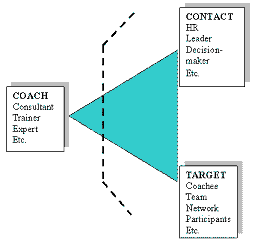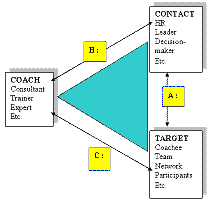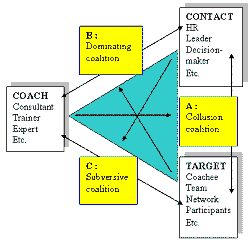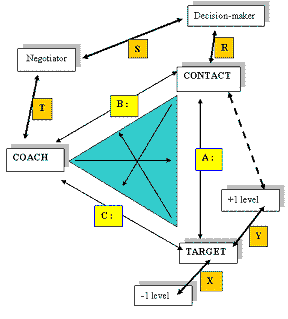Simply put, the three-way or triangular contract concept illustrates the complexity of formal three-way agreements and partnerships. In coaching, three-way negotiations characteristically occur when coaches accompany clients who belong to such systems as families, corporations, teams and other social and professional organizations.
This article first develops some of the original reflections permitted by the three-way or triangular contract concept and then proposes means to map out common, more complex relational webs often found in indirect and prescribed coaching situations. The main theoretical reference for the text and terms below originate from the Transactional Analysis triangular contract concept first developed by Fanita English on the one hand, and from Systems Analysis on the other.
Beyond the coaching field, we suggest that other communication and relationship professionals such as consultants, trainers, therapists, social workers, etc. pay the triangular contract concept all the attention it merits, as it also immensely useful in those related fields.
We would also like to stress that one of the best ways to explore the complexities and specific issues a communication professional regularly faces when negotiating triangular contracts and agreements is to engage in individual or collective supervision sessions. These practical learning environments for communication and relationship professionals offer excellent opportunities to work on the complexity of such three-way professional situations and help clarify the numerous ethical issues that may arise.
In the coaching profession, the triangular contract concept reveals possible strategic interactions between a coach and several other significant actors within client organizations or systems. Interactions within these complex situations include more than two interfacing people or groups and often involve a high level of personal or collective energy. The triangular contract concept can be useful to reveal and work with multiple hidden agendas, political objectives, strategic goals and personal expectations.
Note that this presentation on the concept differs from the original proposed by Fanita English. The original concept was more appropriate to illustrate triangular or three-way relationships between a social worker, a prescribing judge and a designated client, often a social misfit. The latter was to be both accompanied and monitored by a social worker to help secure their reinsertion in society. The model proposed below is more adapted to personal and corporate contexts and particularly concerns prescribed training, consulting and coaching contracts. Obviously and by extension, the triangular contract can also be used to help clarify a host of other three-way agreements.
GENERAL CONTEXT
- Example: Imagine a corporate HR who calls on coaches or consultants to have them implement coaching, training or consulting processes for the benefit of a designated third parties such as persons, groups or intact teams, all members of the HR's organization.
The three roles mentioned above could be played by a number of different people or functions in analogical triangular situations.
- The HR representative is the “contact”. This role could also be held by a buyer, an operational manager, a hierarchic decision maker or a leader.
- Depending on situations, the “coach” position could be held by any provider, consultant, trainer, external expert or internal functional support staff.
- The designated third party or “target” could be an employee, a manager, a system such as a team, or a more informal group such as employees, the personnel, an audience, salespeople, etc.
To initiate our reflection on the triangular web of relationships between the above three categories of actors, we suggest the following figure: an equilateral triangle, with one of the categories of actors positioned at each of the angles.

This triangular configuration of the tree-way contract illustrates the fundamentally different position held by the coach, the consultant or external provider. This person is normally originates from outside of the organization or system represented by the dotted line. In the case of an internal relationship with a functional support staff, this person is external to the vertical or hierarchically executive line. The other two actors or roles on that vertical line are usually more directly involved with each other within an operational structure. They share a more specific organizational context. It illustrates that in most cases, the contact holds a position that is senior to the targeted individual or group.
Note that the sides of the triangle correspond to three distinct and oftentimes consecutive relationships or interfaces, as illustrated below. The HR already knows the target and has a perception of the latter’s issues and needs (relationship A). The contact or HR then calls on and meets the coach, trainer or consultant to brief them on the target’s perceived needs and issues (relationship B). The coach then meets the target and works with them to attempt to satisfy those stated or predefined needs and issues (relationship C).

The A relationship not only precedes the other two, but may often rest on a long history. Its nature is generally coherent with the organization’s culture and professional context prior to the coach’s or consultant's arrival. In the triangular contract’s representation, this relationship is also considered more or less directly hierarchic: the target is subordinate to the contact’s organizational level if not directly reporting to the latter.
The B relationship takes place during the negotiation between the provider called in by the HR or contact. At minimum and in most cases, the contact will detail the target’s needs and issues in the latter’s absence. This formulation of the target’s needs and issues will serve as a foundation for the contract. In many cases, the coach or supplier considers that this contact is in effect the real client who represents the organization's interests and pays in the end.
The C relationship is the last one to enter into the picture, and the one that is often central to the operational dimension of triangular contracts. It is the relationship within which the supplier’s competencies are expected to be demonstrated, to the satisfaction of the contact’s defined needs and goals. This relationship takes place when the coach or consultant meets the target, implements a formal or informal diagnosis and follows-up with the negotiated coaching, training or consulting process.
Triangular Contracting Blind Spots
Note that the three binary relationships or interactions illustrated above each include only two of the three actors. Each relationship takes place in the absence of a different third party. In turn, each actor is absent from the interaction between the other two and can consequently imagine or fantasize that a sort of secret coalition is being formed out of their presence or control. The hidden relationships in the triangular contract leave enough space for each party to invent, suppose, or fantasize a risky secret coalition resting on a hidden agenda. The following drawing illustrates the presence or nature of three possible types of triangular contract fantasies, each with its different set of secret objectives.

Note that the three blind spots and fantasies that may accompany them can be experienced very differently by different actors depending on whether the absent partner feels they are in a superior, dominant situation or in an inferior or fragile position compared to the two other actors.
The consultant, coach or equivalent does not really know the nature of the relationship between the contact and the target before being invited into their context or environment (relationship A). The coach could therefore imagine that there exists a strong conscious or unconscious coalition between the two. This coalition can rest on a more or less long-lasting historical culture proper to the system. As most cultures, it could have an exclusive dimension, difficult to breach by outsiders. The coach can fantasize, for instance that all the members of the client organization are protecting themselves from the external world and resistant to any influence that would provoke real change in their professional equilibrium. When it is perceived by the coach or consultant, this type of defensive partnership proper to the client organization is called a collusion coalition.
The collusion fantasy is sometimes confirmed by external coaches or consultants when they later indirectly uncover information that is vital to their mission’s success but that was purposefully or accidentally omitted by the two internal actors during initial briefings.
Likewise, the target person or group is generally not invited to attend the external provider’s initial meetings with the contact person or HR (relationship B). This targeted person or designated group can fantasize about hidden agenda items that may have an effect on their success, career or professional context. The targeted individuals or group could mistrust the other two actors’, their goals and their possible coalition. They could construe the existence of indirect manipulative or organizational objectives which could be contrary to their interests as a targeted person or group. This fear or mistrust is called the target’s domination fantasy.
- Note that if the target person or group is designated by the internal contact, this rests on a diagnosis that establishes a need or an issue, in the target’s absence and without their explicit approval.
Consequently, the fact that coaches or consultants agree to focus on designated organizational targets could be interpreted as an obvious proof that they share a common secret diagnosis with the organization’s contact. All seems to indicate that this preliminary diagnosis designates the target as being centrally responsible for important organizational issues.
Once the coach, consultant or trainer meets the target, the contact moves out of the picture and lets them do their work. This third relationship (relationship C) consequently takes place out of the contact’s immediate control. The contact could feel that it is necessary to keep an eye on this relationship so as to make sure it doesn’t get out of hand. What if the external providers and target person or group come to an understanding that the designated organizational issues are of someone else’s responsibility? What if they both agree to change the fragile equilibrium within the organization and point out that responsibility for real positive and sustainable change lies elsewhere? The possibility for a coach-target coalition as perceived by the contact is called the subversive fantasy.
These three blind spots and their three corresponding fantasies give an indication of areas that call for special attention when negotiating and implementing contracts in complex organizational contexts.
Possible clarifications concern the three hidden relationships illustrated by the triangular contract. These clarifications can allow the elaboration of different constructive or protective strategies that could be implemented by the coach or consultant. Consider the following strategies below, that could be an integral part of any individual or collective coach contracting process in most corporate contexts:
- The coach can insure transparency through the systematic use of written contracts that can be shared with all concerned parties.
- From the start of the coaching program and throughout its evolution, the coach could avoid attending meetings with the contact or hierarchy in the absence of the target or target representatives,.
- The coach can establish numerous written briefs and share them between all the concerned parties throughout the unfolding of the coaching process.
- The coach can establish numerous tripartite meetings, at minimum at the onset and the end of the coaching process, and whenever there appears the need tor substantial contract modification or validation.
- The coach can get all parties to agree to precise measures and measure instruments to focus the coaching process on specific goals established by all the parties, ensuring the target’s success.
- The coach can establish confidentiality clauses that specify what remains confidential in the work with the target group, what can be shared, and how.
To consult an article on establishing coach-client agreements and contracting
These and other standard operating procedures in coach three-way contracting may help keep designated coaching triangular relationships ethical, sustainable and healthy in most organizational contexts. That will not alter the fact that in difficult organizations and triangular situations, all parties often hold on to their fantasies and remain very cautious as to the possibility of multiple hidden agendas.
OTHER ABSENT PARTNERS
The complexity of most real situations in the corporate world can often include a number of other hidden pertinent actors. Coaches could well be advised that in a large number of situations, the above three-way contract could be extended to directly or indirectly involve many more people, sometimes lurking in the shadows. Some of these could well be brought into the coaching in order to achieve success in their accompanying process.
The coach, consultant or trainer could be a member of a larger organization, that may be at the origin of the contract negotiation. That coaching or consulting organization’s leadership or sales team may have quite an influence on its operational results on the longer run. If the client contract is negotiated by such a fourth party and then subcontracted or delegated to the coach, more complexity could be at hand. The coach or consultant that ends up working with the target may discover that needs and issues in the field do not correspond to the initial description of the stated mission, as described during the original negotiation.
The target person or group may be in daily contact with indirect beneficiaries such as clients for a salesperson, or personnel for a manager. This -1 level, subordinate to the target person or group may even be at the origin of the defined coaching need, and may expect measurable results. This indirect beneficiary may ultimately be consulted or measured to evaluate the effectiveness of the coaching process.
The target person or group may also have a leader or leadership group just above, different from the contact, in the original triangular relationship. This is the target’s +1 level. It is hierarchic to the target person or group. This level may be quite instrumental to the success of the coaching mission, if not the person or group mainly responsible for the expected measurable results. Oftentimes, the main success factions for the target group and for the contact reside on this management or leadership level in the organization.
The contact may also be under pressure from upper echelons in the organization, or from an immediately superior decision maker who is expecting visible results in predefined dimensions that may be of a more political or strategic nature. The object of the coaching process may sometimes be tied to hidden interpersonal, confidential or political organizational issues originating from that level, and that have not been clearly exposed to the contact or coach.

WHO IS THE CLIENT?
In this all too common and complex environment, it may become very difficult for a coach or consultant to decide whom should be considered to be the real client person or group. This choice is often between one of two options:
- Either the coach considers that the hierarchy is paying and defining organizational vision, mission, objectives, goals and means. Consequently the final word is top down and should be pronounced by the most hierarchical available actor in the system.
- Or the coach or consultant considers that the designated target and lower echelons of the systems are the ones closest to being competent to defining their real needs. According to this coach frame of reference, these actors should consequently have the final word when defining operational coaching objectives.
Often, this choice is predictably related to the coach’s or consultant’s personal profile and professional preferences. Does the coach personally identify with the employee or designated target, or does the coach identify with the organizational hierarchy and decision makers?
Whatever the choice of sides, any choice is the best way to become incompetent in the eyes of the other half of the system. Indeed, it is generally observed that when coaches side with hierarchy, they loose credibility with the targeted personnel, if, however, they side with the personnel, they loose credibility with hierarchy. On which side one should choose to play the game of coaching? or who should on favor when defining a coaching strategy? is therefore the wrong way to put the question.
A more systemic answer for coaches is to consider serving the system rather than any single one of its members or representatives. Each of the pertinent actors within the organization could or should be perceived by the coach as functional representatives of the organization as a system, regardless of each one's individual vision or personal interests.
- Consequently, in all systemic coaching situations, all of an organization’s actors are to be considered coaching targets, all the time.
SYSTEMIC COACHING IN TRIANGULAR SITUATIONS
If coaches are ever to consider one person’s responsibility in any organizational issue or problem, they are to immediately consider every other pertinent actor’s responsibility in the same issue or problem. If they are ever to compliment one actor on an achievement, they are to immediately underline every other actor’s participation in making that achievement possible. This strategy is one which continuously consists in revealing and working with organizational interfaces rather than with persons.
- In effect, systemic coaches should consider that they are paid to accompany organizational systems rather than individuals, teams, leaders or managers.
In keeping with this systemic frame of reference, consider the first meeting with a contact, organized to inform a systemic coach of a target person’s issues and needs. The type of relationship established with the coach often illustrates the quality of internal relationships in the organization. The systemic coach could therefore consider the following questions: -
- Are you treated respectfully, received on time and with sufficient time? Are you considered as a partner, as a subordinated supplier? Are you treated someone who should be tested and evaluated? Are you given all the information you ask? Is the relationship transparent and trustful? Are you being sold the organization as would a public relations official? Are you being challenged on your means? Are you being pressured? Are you swamped by over-detailed information? Are you given space to ask questions and are your questions clearly answered? Are your suggestions considered and accepted or are they brushed away? Are you expected to fit into a well-defined box and just do your job? How are the different relational patterns established with you illustrative of those established with your prospect, and of how your prospect is treated?
The systemic coach could ask the organization contact and other members some of the following questions:
- Are there other coached people in your company? In this department? In this team? What is their profile? What is the object of their coaching, in general?What have you done to support this prospect person in the past? What have you done that was successful? Are there other coached people in the same team as the prospect? How present and supportive do you believe is this person’s manager? Is that manager coached or has that manager been coached in the past? Can that manager be interviewed ? How long has the prospect for coaching been in the same position? How is that prospect’s profile fit well in the organization? What is the next expected career position for that person? Supposing the coaching process does not achieve expected results, what is your next option? If the coaching process leads to your prospect wanting to leave your company, what is your reaction to that? What do you think this prospect expect from you and never dared to ask? What should you have told this prospect months ago? How are people groomed to fit into the organizational culture? How is diversity cherished in your organizational culture? If this prospect for coaching was revealing organizational limits or challenges, what would those be? Etc.
With the contact person or any other individual that the coach can meet in the organization, the aim of this type of question is to provoke food for thought. Although these questions may directly or indirectly concern the designated prospect, they are principally tailored to provoke everyone else with new perspectives on the organization in general and on their personal role in its political equilibrium. This approach is based on the principle that also the organization’s role may well be to single out individuals that may or may not need coaching, a systemic coach posture is to consider that every single person in an organizational system is a potential coaching prospect or target, officially or not. Everyone can formally or informally be asked coaching questions, in order to provoke developmental dialogues.
CONCLUSIONS
Practically, this could go so far as to expand all prescribed coaching contracts to include sequences during which the coach would also officially work with the contact, with the prospect’s immediate hierarchy, with some of the absent beneficiaries, with the initial contract negotiator, with the absent decision makers, etc. In all coaching contracts concerning designated clients, the more coaches can officially include other pertinent actors, the more they can transform potential scapegoating processes focused on individuals into system-oriented evolutionary processes involving shared responsibility.
These last considerations about systemic coaching strategies may take us a step beyond the initial object of this article which is to share an understanding and possible uses of the triangular contract concept. To conclude, however, consider that good knowledge of the three-way contrat concept often permits a clearer understanding of complex triangular situations: those that include multiple significant actors, positions and strategies. The triangular contact concept and some of its variations and extensions explained above can help a consultant or coach gradually develop a more systemic, strategic, or constellation-type perception of the bigger picture. This can help one gradually move from a purely individual coaching approach to one that accompanies more complex client organizations, as complex coherent systems intrinsically worthy of attention.
For a systemic coach, organizational clients are not simple, singular people designated by internal contacts. They are an intricate web of relationships that need to be addressed as such, even when, or especially when these approach the coach with a singular target. Beyond the simple designated client, each person the coach meets or hears about can be a pertinent actor in the general system constellation. Each one of them needs to be perceived as totally responsible to ensure the success of the coaching mission.
Copyright 2008. www.metasysteme-coaching.eu Alain Cardon



